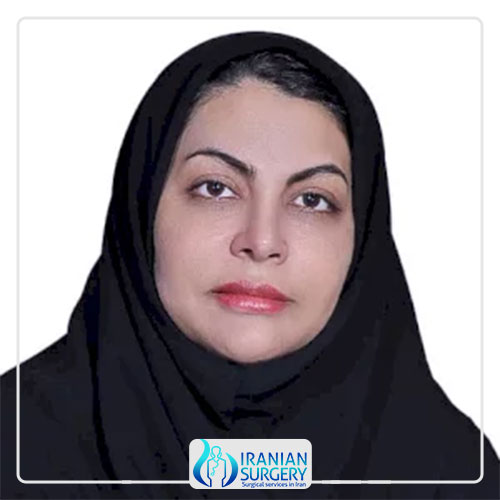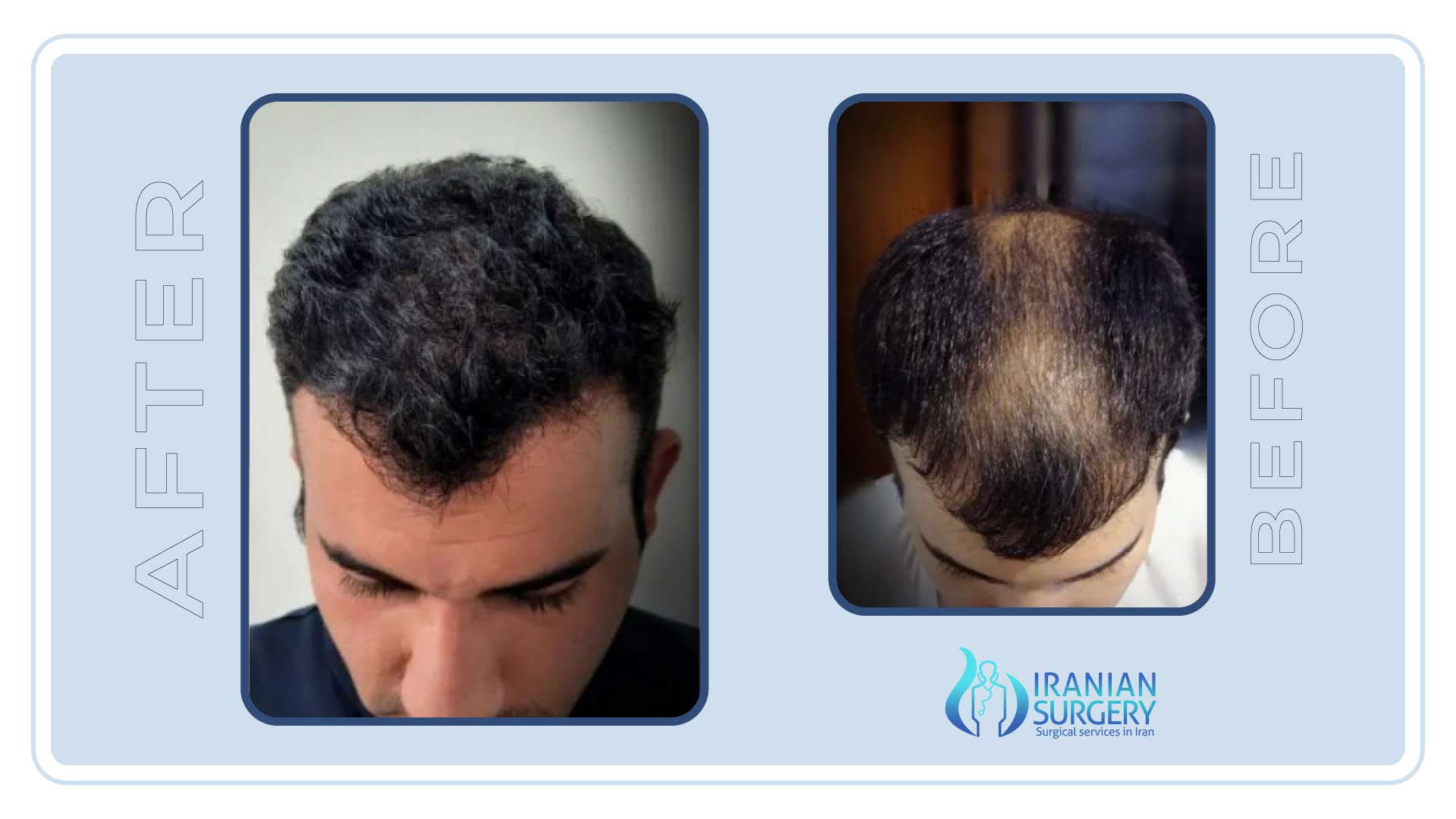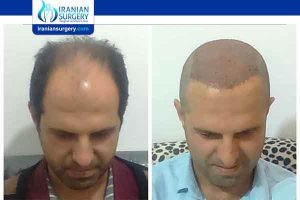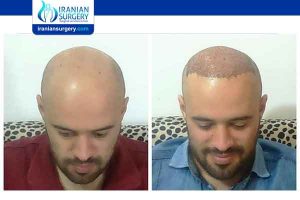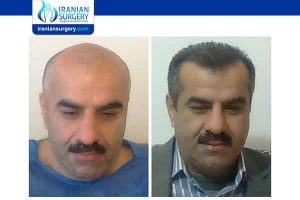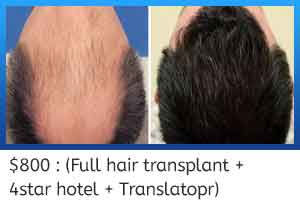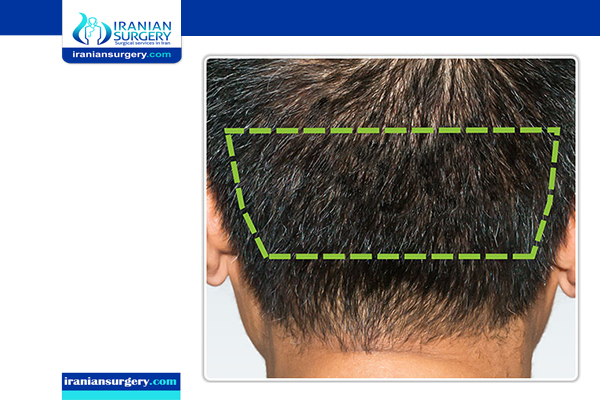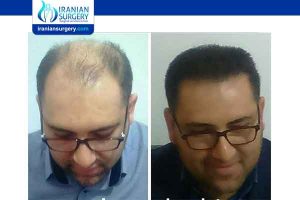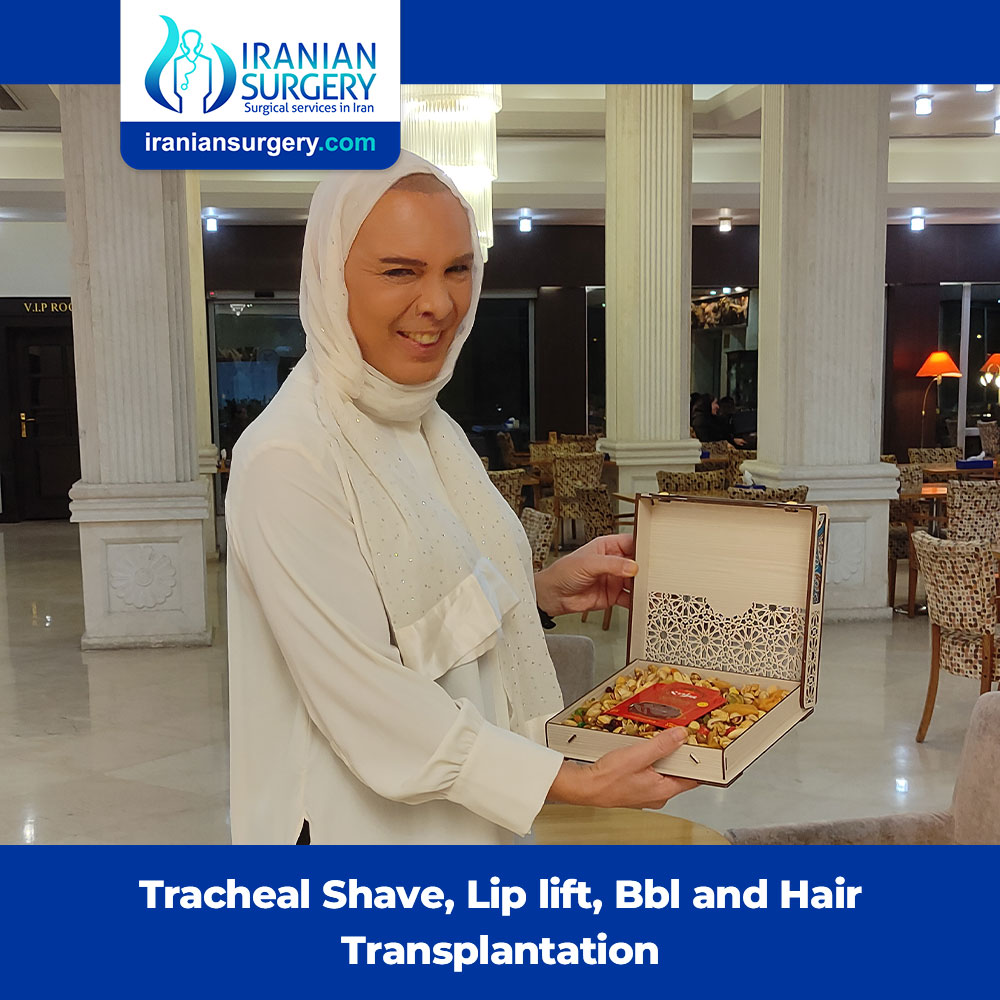Hair Transplant in Iran
Clinic Stay: 1 Day
Anesthesia: General
Total Stay: 5 Days
Recovery: 1 – 6 months
Back to Work: 5-7 Days
The stress of today’s world manifests itself in most people with hair loss and baldness, both in women and in men – if they are not genetic – but this is treatable. In hair transplantation, the skill, delicacy, and experience of the hair transplant technician, Trichologists and Dermatologists, and the donor part of your hair guarantee a successful operation. Hair transplantation in Iran and with Iranian Surgery Company means skilled doctors and technicians with more than 15 years of transplanting experience, the proper hair transplantation methods for your hair, and the best hair transplantation clinics in Iran. update
In addition, in the continuation of the hair transplant process, providing suitable supplements to take care of the newly transplanted hair, follow-up, and constant online availability will help you have a successful hair transplant experience in Iran. For further questions and to chat with our cosmetic consultants, feel free to send us a message via WhatsApp. Our commitment and responsibility are to be there for you to choose the most suitable package.
Recommended Hair Transplant Packages in Iran
Shiraz
All Inclusive-
E-Visa
-
The Surgery & Medical Package, Hair Supplements
-
Accommodation: Economic and VIP
-
Medical Interpreter
-
Airport Shuttle and Medical Transportation
Tehran
All Inclusive-
E-Visa
-
The Surgery & Medical Package
-
Accommodation: Economic and VIP
-
Medical Interpreter
-
Airport Shuttle and Medical Transportation
Mashhad
All Inclusive-
E-Visa
-
The Surgery & Medical Package
-
Accommodation: Economic and VIP
-
Medical Interpreter
-
Airport Shuttle and Medical Transportation
Hair Transplant Cost in Iran
On average hair transplant cost is $8000 globally while cost of hair transplant in Iran 2023 is around $1000, The minimum hair transplant cost in Iran is $500 (shiraz) and the maximum cost of hair transplant in Tehran is $ 1300.
Hair transplant Cost in Iran,Tehran at 2023:
Hair transplant Cost in Iran,Tehran at 2022 starts from $800 which can be done by FUE or FUT or DHI method Based on doctors opinion.
Hair Transplant Cost in Iran,Shiraz at 2023:
Hair transplant in shiraz at starts from $ 500 and its being done by the best medical team and experienced Doctors.
Why is Iran the best country in the world for hair transplant?
Why hair transplant in Iran?
The main reason is that Iran benefits from the best hair transplant technicians and the second reason is the affordable price.
Iran offers the most affordable hair transplant prices compared to other countries such as Britain, Turkey and the United States. In Iran, the cost of a hair transplant is between $ 500 and $ 1,300, which includes the cost of accommodation and transportation, clinic and doctor while in other parts of the world, such as Istanbul, New York, Dubai and other capitals, the minimum cost is $ 3,000 and reaches $ 30,000.
Due to the low cost of hair transplant in Iran as well as well-Equipped and modern hair transplant clinics, thousands of people travel to Iran every year to undergo hair transplant in Iran with the experienced and skilled doctors at an affordable price.
Hair Transplantation in Iran; Why?
According to statistics, many people choose Iran for hair transplants. In addition to the percentage of successful hair transplants, Iran is economically profitable by providing services at an international level. In this clip, our colleague explains these things in more detail.
Hair Transplant Doctors in Iran
When it comes to surgical hair restoration, it’s crucial to work with a surgeon who is experienced in the procedure. Board-certified cosmetic surgeons in Iran who specialize in hair restoration and operate in best hair transplant clinics in Iran will be able to provide you with optimal results in a safe environment. with that said, best doctors are not the only reason you should consider hair transplant in Iran. Unique economic conditions have enabled Iranian surgeons and clinics to offer their world-class services with more affordable prices than almost anywhere in the world. that’s why, every year patients from all around the world come to Iran to undergo surgical procedures one of the most popular of which is hair transplant. what’s more these lucky patients will come to enjoy the exceptional environment and amazing cultural atmosphere along with considerably lower cost of medical services and accommodation.
Best Hair Transplant Doctors in Iran
How can I find the best Hair Transplant Doctor in Iran?
Hair Transplant doctors in Iran can make your face more appealing. Hair Transplant doctors in Iran can also help you in making your final decision about what type of Hair Transplant is more suitable for you.
It is important that you seek the assistance of experienced and skilled Hair Transplant doctors in Iran who have provided a suitable condition for people with limited budgets to undergo Hair Transplant Iran easily. It is worth explaining that the quality provided by Iranian doctors is far higher than other countries including Turkey and India.
Hair Transplant doctors and technicians in Iran, have performed numerous procedures annually which make them more experienced than other countries’ doctors, due to high demand and low cost of hair transplant in Iran, thousands of people travel to Iran every year so that they can undergo hair transplant Iran with the best hair transplant doctors at an affordable and reasonable price.
The factors that the best Hair Transplant doctors and technicians should have:
Experience
Because of performing a great number of procedures, they become knowledgeable and highly skilled which make them very famous worldwide.
Expertise in different types of Hair Transplant surgery
It is of paramount importance that your surgeon be expert in various types of Hair Transplant including FUE and FUT.
We are happy to introduce a great number of Iranian doctors and technicians who have all two above-mentioned features.
Best Hair Transplant Clinic in Iran
When it comes to surgical hair restoration, it’s crucial to work with a surgeon who is experienced in the procedure. Board-certified cosmetic surgeons in Iran who specialize in hair restoration and operate in best hair transplant clinics in Iran will be able to provide you with optimal results in a safe environment. with that said, best doctors are not the only reason you should consider hair transplant in Iran. Unique economic conditions have enabled Iranian surgeons and clinics to offer their world-class services with more affordable prices than almost anywhere in the world. that’s why, every year patients from all around the world come to Iran to undergo surgical procedures one of the most popular of which is hair transplant. what’s more these lucky patients will come to enjoy the exceptional environment and amazing cultural atmosphere along with considerably lower cost of medical services and accommodation.
Best Transplant Doctors in Iran
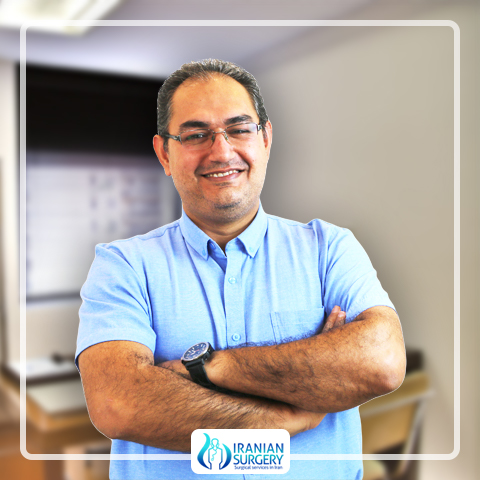
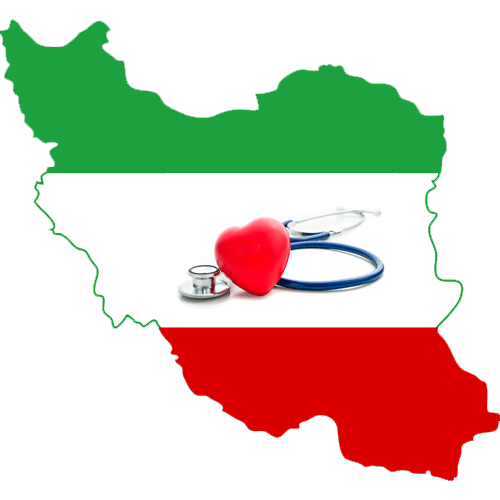
Shiraz, Iran
Kowsar Hospital
Dr. Dastjerdi
Plastic Surgeon Specialist
Specialist Plastic Surgeon, Cosmetic and Rhinoplasty Surgeon
Board-Certified Plastic Surgeon
Member of the Iranian Plastic Surgeons Association.
Angel from Germany:
I had a nose job and breast implant surgery with Dr. Dastjerdi in Iran, and I am almost satisfied with the result of the operation.
Elka from Sweedon:
I had liposuction and rhinoplasty surgery with Dr. Dastjerdi and his work was excellent, with no bruises under the eyes. He is well-mannered and well-educated.
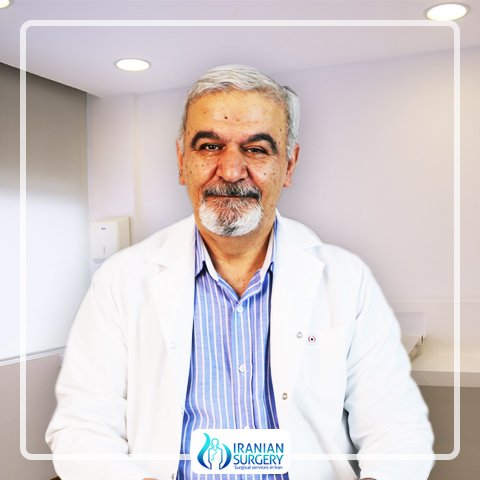

Shiraz, Iran
Kowsar Hospital
Dr. Gandomi
Plastic Surgeon Specialist
Otolaryngologist (ENT)
Associate professor at Shiraz University of Medical Sciences
Studied in Shiraz and completed a postgraduate course in America, Australia, and Austria in the field of rhinoplasty and endoscopic sinus surgery, nose surgery, and cosmetic and deviated septums.
Patricia from Italy:
Dr. Gandomi is excellent and explained the nose job perfectly. I went to him for my broken and deviated nose, and he fixed me. I was in pain for days after having this septum/rhinoplasty in Iran, but now that I am back, I am fine and happy with the result of the operation.
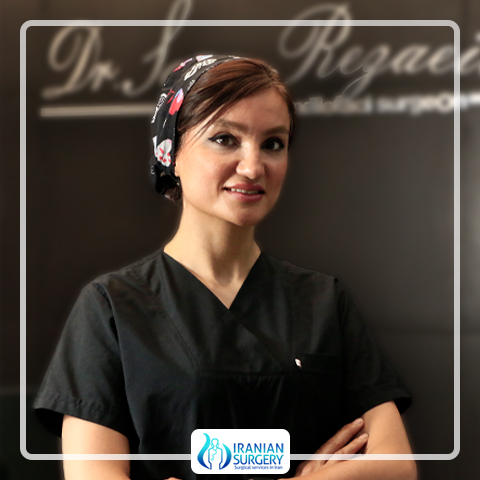

Shiraz, Iran
Dr. Rezayi Farid
Plastic Surgeon Specialist
Maxillofacial Specialist
Specialized Surgeon in Face, Head, Neck, Nose (Rhinoplasty and revision rhinoplasty), and Jaw surgery, Chin Implant, Jaw Augmentation, and V shape Jawline
Samantha from Australia:
I am happy with Dr. Rezaei Farid. I had jaw surgery for V shape jawline done by her, and it is good now.
Muthar from Dubai:
Hello, Dr. Rezaei Farid’s work is excellent. I am with her. My nose was a problem, it was crooked, and my lower jaw was too far forward. I am satisfied with the results of both operations.
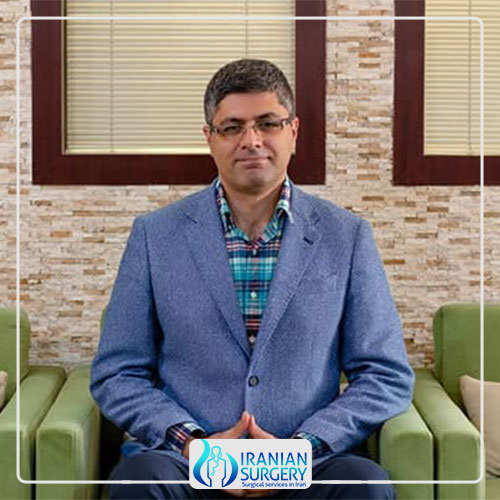

Tehran, Iran
Dr. Vahab Astarki
Plastic Surgeon Specialist
Dr. Vahab Astarki is a plastic surgery specialist for cosmetic facial and body surgeries and has much experience in the field. He performs his surgeries using the best and latest techniques of the world’s medical science.
Kate from England:
I had facial and body cosmetic surgery done by Dr. Astaraki. His work is excellent, and the facilities of his clinic where I had my operation were also perfect.
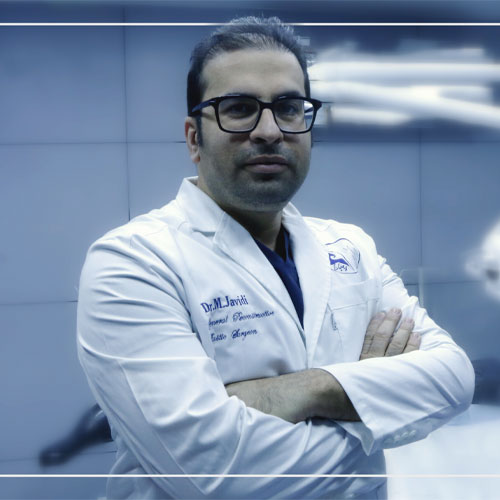

Shiraz, Iran
Dr. Mohammad Javid
Plastic Surgeon Specialist
Dr. Mohammad Javid – Cosmetic and reconstructive surgery of abdomen and chest. Breast prosthesis. Abdominoplasty, body contouring, gel, botox, fat injection, threading, mammoplasty, jaw and face angulation in Shiraz
Mahmood Al-Boyut From Qatar:
Dr. Javid was great for nose surgery in Iran.
Siankala from South Africa lives in Dubai:
I had a nose job with Dr.Javid, and I am satisfied. My new nose is natural, and Dr. Javed is very polite and skilled.
Hospitals
Hospitals are usually presented based on the excellency in providing services for patients and their up-to-date medical equipment. In these hospitals, patients request rhinoplasty in Iran (nose job) or a variety of plastic surgeries such as breast lifts, facelifts, abdominoplasty, BBL, liposuction, jaw and facial cosmetic surgeries, and therapeutic surgeries so that they can achieve their goals and surgery and their health and mental safety could be guaranteed. Patients can check their options based on the type of surgery, the hospital level of progress, and the doctors/surgeons working in the hospitals.
- Kowsar Hospital was founded in 2005 by a group of benefactors.
- The super specialty medical center comprises of 18 advanced modular operating theaters and angiography procedure rooms.
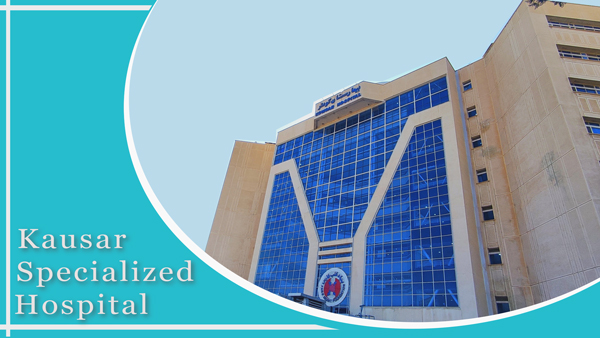
Before & After Photos
Take a look at ‘before and after’ photos of people who got their nose jobs done in Iran.
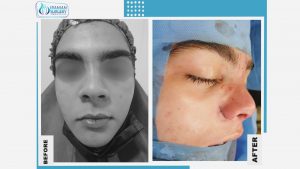
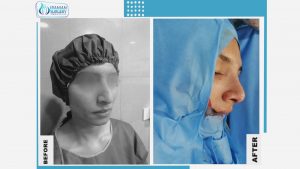
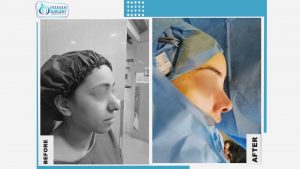
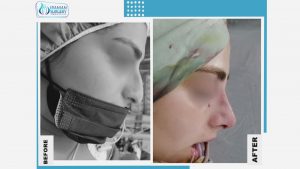
Hair Transplant in Iran
Having thick and healthy hair plays a very important role in showing a younger face. Unfortunately, a large percentage of people, especially men, lose all or part of their hair for various reasons. Natural hair transplantation is a method in which natural hair is transferred from a donor site which in most cases is the back of the head or around the head to the front or top of the head.
Hair transplant has become one of the most popular and natural methods of surgery. And Iran has managed to become the best destination for this operation, but why?
Among the many reasons for this success are the low cost of this operation despite its high quality plus the considerable experience of the doctors. With just a simple search you will notice that every year a large number of hair transplants are done in Iran which in turn has resulted in highly skilled doctors and high rate of patient satisfaction. Hair transplant in Iran is performed in specialized skin and hair clinics of the Iranian Surgery team with the latest methods and by the most skilled medical teams.
To enjoy our best services, all you have to do is get in touch with our support team through email or WhatsApp.
FUE vs. FUT: What Type Of Hair Transplant in Iran Is Best For You?
There are two primary techniques for hair transplant currently in use – the FUE (Follicular Unit Extraction) and the FUT (Follicular Unit Transplantation). Due to the high success rate of the FUE method, which is more than 95%, most doctors in Iran perform this method.
Hair transplant method in Iran
The vast majority of hair transplant clinics in Iran prefer the FUE method (follicular unit extraction) due to the least pain during recovery, the least scarring and durability of hair follicles after transplant.
Hair Transplant Review in Iran
This patient is a 39-year-old man who came to Iran from Dubai for Hair Transplant (FUE Method). In this method, each hair is extracted as a whole unit, and then transplanted to the new area. Although less invasive, the procedure is very intricate and this can lead to an FUE procedure taking slightly longer than the FUT method. By taking more time, the healing period is reduced and the levels of success are greater. As you can see in the photos, the result of hair transplant looks completely natural and the patient is very satisfied with the services of Iranian surgery and the result of hair transplant.
This patient is a 29-year-old man who came to Iran from Qatar for Hair Transplant. We used a combination of FUT and FUE methods for him because he did not have adequate hair follicles to use for the transplant. Six months later, we did the hair transplant again using the FUE method. As you can see in the photos, the result of hair transplant looks completely natural and the patient is very satisfied with the services of Iranian surgery and the result of hair transplant.
This patient is a 45-year-old man who came to Iran from Abu Dhabi for Hair Transplant. We used a combination of FUT and FUE methods for him because he did not have adequate hair follicles to use for the transplant. Six months later, we did the hair transplant again using the FUE method. As you can see in the photos, the result of hair transplant looks completely natural and the patient is very satisfied with the services of Iranian surgery and the result of hair transplant.
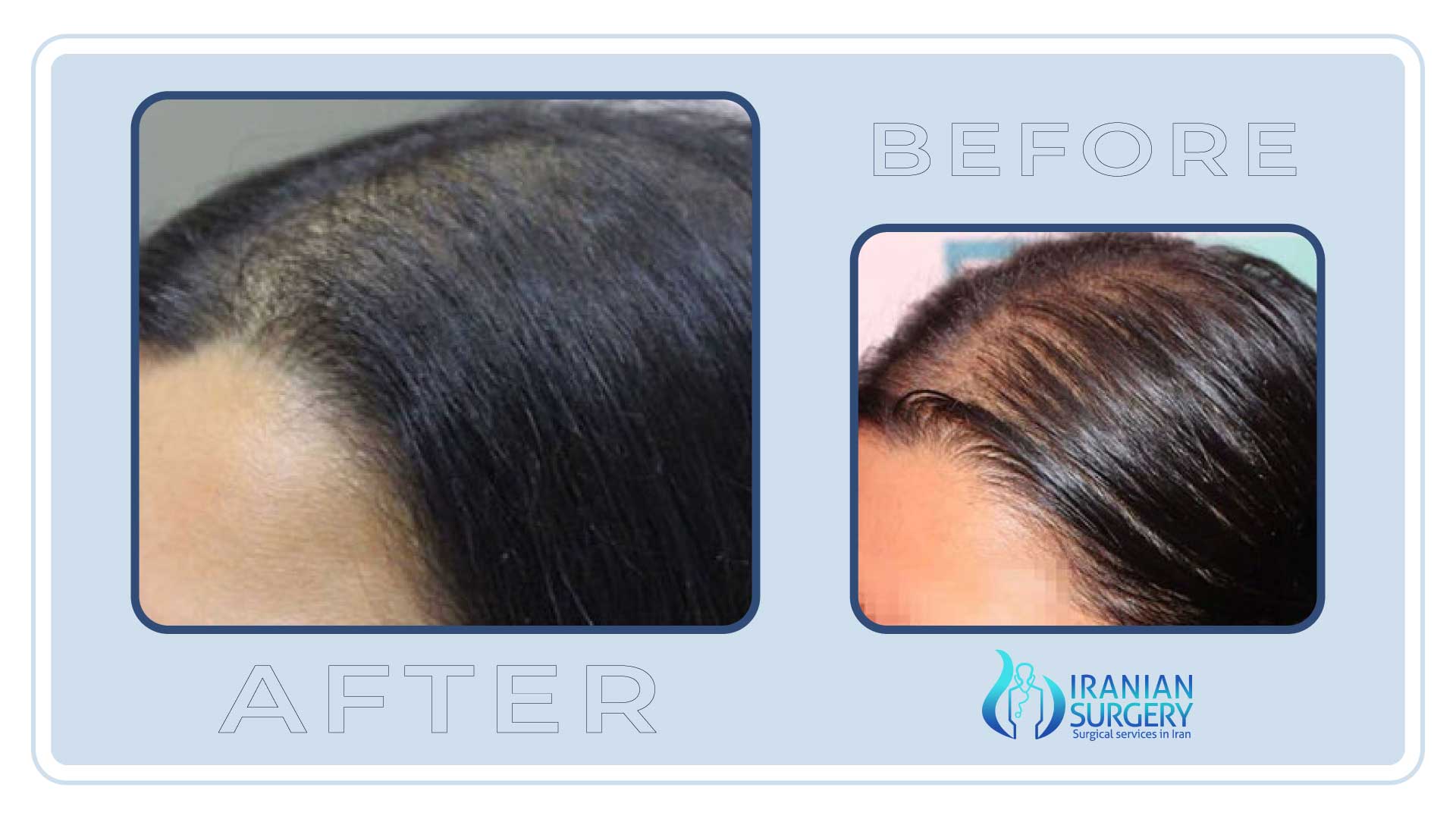
Hair transplant in Iran Step by Step
I decided to have hair transplant in Iran, What should I do?
If you want to undergo hair transplant operation in Iran, let’s try to explain the procedure step by step.
First of all, you will be subject to a research process. For this purpose, you are often expected to contact a center via online channels.
In this context, you can do a web search. And then, the relevant department will contact you. A preliminary evaluation is generally asked for hair transplantation. Patients tend to send their photos to the doctor via WhatsApp and thus, the doctor will have a general opinion based on these photos.
Clinics in Iran ask for at least 3 photos of patients during online consultation for hair transplantation. These photos include clear images of the front, slightly top area of the balding site and the back of the head. These three photos will show how many grafts are required in the transplantation site and whether hair follicle that can meet this requirement is available.
Although clear photos are requested, it will not be possible to plan the operation without an actual physical examination.
After this preliminary assessment, clinics may send you a form and a pre-assessment document where this evaluation is noted.
What is Hair Transplant?
Hair transplant also known as hair restoration, hair transplantation and hair replacement surgery is a surgical technique in which new hair follicles are transplanted from a hair-loss resistant area to a balding or hair thinning area. It is a permanent replacement treatment to restore the hair in the balding area. Thus, it is a permanent natural looking solution for patients suffering from balding conditions or receding hairlines.
Hair transplantation can also be used for other body parts such as to restore eyelashes, eyebrows, beard hair, chest hair, pubic hair and to treat scars caused by any accident or surgery.
Pattern baldness is responsible for the majority of hair loss. This comes down to genetics. The remaining cases are due to a variety of factors, including:
- Diet
- Stress
- Illness
- Hormonal imbalance
- Medications
Before Hair Transplant
When to consider Hair Transplant
- If you have thinning hair
- If you have bald spots
- If you have a receding hairline
Preparing for your procedure
How do I prepare for a hair transplant procedure?
Your surgeon will provide thorough preoperative instructions, answer any questions you may have, take a detailed medical history, and perform a physical exam to determine your fitness for surgery.
In advance of your procedure, your surgeon will ask you to:
- Stop smoking at least six weeks before undergoing surgery to promote better healing.
- Avoid taking aspirin, certain anti-inflammatory drugs and some herbal medications that can cause increased bleeding.
- You may be asked to take a shower and wash your hair with regular or antibacterial soap.
- Regardless of the type of surgery to be performed, hydration is very important before and after surgery for safe recovery.
- Hair transplant surgery is usually performed on an outpatient basis. Be sure to arrange for someone to drive you home after surgery and to stay with you at least the first night following surgery.
Read more about : Hair transplant stages
What can I expect on the day of hair transplant surgery?
Hair transplant is usually performed with local anesthetic and is performed in an accredited facility. This may be a hospital, clinic or office-based surgical suite. Hair transplant procedures take six to eight hours to complete. Your surgeon will give you an estimate of how long your surgery will last based on the details of your surgical plan. You will receive instructions on how to prepare and what to expect. This is what you can anticipate:
- The donor area(s) will be trimmed so that the surgeon can access and remove the hair grafts.
- The entire head will be shampooed and cleaned to prevent infection.
- Oral or IV anesthesia may be administered to help you relax during the surgery.
- A local anesthetic will be injected into the scalp.
- The method that you have decided on will dictate what techniques the surgeon will use to remove the hair follicles and transplant them into the skin.
- Usually, the surgeon will space out the grafts to achieve maximum retention.
- Afterwards, the scalp will be cleaned and covered with gauze.
- You may have to wear a pressure bandage to aid healing.
You will probably be permitted to go home after a short observation period unless you and your plastic surgeon have made other plans for your immediate postoperative recovery.
Who are the Ideal Candidates for a Hair Transplant Procedure?
. Men who have been losing their hair due to male pattern baldness for more than five years or who have progressed to a Norwood class 3, which is the earliest stage of male hair loss, or above.
. Men who have realistic expectations and who understand that their hair loss might continue to progress even if they are taking prescription medication to stop the progression.
. Men who have been balding for many years and whose pattern has stabilized and are interested in growing hair to provide a more youthful appearance.
. Men and women who have lost hair due to trauma or burns.
. And someone who has adequate hair growth or follicles that can be used for transplant.
Who should avoid undergoing Hair Transplant?
. This procedure is done under the effect of local anesthesia, so it does not directly interfere with the functioning of the heart, etc. But, there are always risks to the patients having serious heart diseases and they should consult with the surgeons before taking the treatment.
. Heavy drinkers and smokers are also not allowed to undergo the treatment because of the risk of internal and external bleeding. If they have to take the treatment, they have to abstain from their drinking and smoking habits at least a few weeks before the time of the procedure.
. People with diffuse hair loss have inadequate donor supply hence they are advised against undergoing a hair transplant. They have a higher risk that the grafts are too weak and will not take at the recipient area.
. Those who suffer from thinning hair may also not be suitable for hair transplant surgery since there are no distinct bald patches and not enough space to implant the new hair. There is a risk that the new grafts will be rejected or that they will dislodge the neighbouring hair.
. Also, the risks of a hair transplant can be minimised if your scalp is normal or loose. People with a tight scalp are not the best candidates for the procedure, as it would be difficult for the surgeon to insert the grafts.
What are the Advantages and Disadvantages of Hair Transplant?
Pros:
- This procedure works well to provide long term results for male pattern baldness, hair thinning in women due to hormonal fluctuations and in cases of scalp injuries.
- Hair transplantation is more cost effective than medication treatments as the whole cost is incurred in one procedure versus a lifetime of treatment.
- Natural hair growth is the main aim of this procedure, making its effects long lasting.
- The results of the surgery is in the patient’s control, with the eventual aesthetic beauty achieved as per each patient’s vision.
- In procedures like eyebrow transplants, the results look natural in comparison to tattoos or makeup.
Cons:
- Infection of the hair follicles, scalp swelling and itching are the most common side effects of the surgery.
- In some instances there is a chance of losing transplanted hair, and this is referred to as “shock loss.”
- There are small chances for hair follicles to die off before the hair regenerates. And this often causes bumps on the scalp.
- As a part of the scalp is reduced during transplantation, the chance of developing wide scars are increased.
- It might take months for hair to grow into the area
- Multiple sessions spanning over one to two years might be required
What are the risks and Side effects of hair transplant?
Like any surgery, a hair transplant involves certain risks. But with the right specialist by your side, they can be kept at the lowest level possible. In addition, the occurrence of adverse events after a hair transplant is considered to be relatively low compared to other surgical procedures. Here is an overview of the possible risks associated with a hair transplant.
- Poor results
It may happen that the result does not meet your expectations. Either the hair density is too low or the hair grows in an unnatural direction and creates a non-aesthetic image. Failure to match the natural hair growth direction may also result in an unsatisfactory appearance. However, with a trained specialist who has been performing hair transplants for years, you need not be afraid of this risk.
- Pain during or after a hair transplant
Anaesthetic injections may be a bit uncomfortable as they need to be done at several points in the scalp. The use of needles and syringes may scare off some patients.
Moreover, the modern FUE method, which is almost exclusively used in hair transplantation now, is minimally invasive and done under local anaesthesia. Therefore, the patient will not feel any pain during the procedure.
- Inflammation and swelling
Of course, wounds can swell and redden after surgery. These risks of a hair transplant are bound to occur at least for a short time after the surgery has been performed. That is especially the case with the FUT method, where the doctor has to remove the whole strip of skin from the head. Inflammation can be disturbing for the patient, however, it is a normal consequence of any surgical intervention.
The tiny openings that occur during the FUE hair transplant usually heal without complications. Also, if the patient applies some antiseptic and soothing cream, inflammation and swelling will be relieved in 1-2 days. You can also reduce swelling by sleeping on a high pillow with your head elevated.
- Itching
Itching is quite common after surgery, it means that the wounds are in the process of healing. However, you must desist from scratching the itchy areas, since it can displace the newly implanted grafts as well as increase the risk of infection.
- Bleeding
Bleeding may occasionally occur within 2 weeks after the operation. To avoid or minimise it, the patient should never scratch the scalp or pick the scabs. Avoid strenuous physical activities, drinking alcohol, smoking, and taking aspirin within at least 7-10 days as well. If bleeding takes place, put a clean gauze cloth on the bleeding areas and gently apply pressure with your fingers.
- Infection
In the FUE method, the risk of infection is very low due to the less intrusive nature of the procedure. The doctor will most likely prescribe antibacterial cream to the patient to prevent any infection. However, keeping the hygienic standards is particularly important here, which is why it is necessary to check the reputation of the clinic beforehand.
- Scarring
Scarring may be quite visible if the patient has undergone the traditional FUT or ‘strip’ method. With the stitchless FUE method, you do not have to expect apparent scars. The visibility of scars, however, will also depend on how well the wounds can heal, if the scalp is loose or tight and how densely the surgeon implants the grafts.
- The grafts fall out
Some patients experience what’s known as “shock loss,” which causes all of the transplanted hair to fall out at once. However, it’s very unlikely that this hair loss is permanent and typically new hair will grow in its place. This risk can be diminished by a comprehensive preoperative examination of the patient. It is possible to predict how good the grafts will take by assessing the quality of the scalp and hair.
Factors Affecting Successful hair transplant in Iran
Experience is usually the first factor that comes to people’s mind when they are considering all factors affecting the final outcome of hair transplantation. All the factors that influence success are as follows:
- Experience
- The wide availability of health services
- Technical equipment
Facts about hair transplant
1) The transplanted hair behaves like natural hair and sheds between two to four weeks of transplant. The roots thereafter start sprouting hair naturally and continue to do so for a lifetime.
2) Use of local anesthesia makes it a painless procedure and the patient can go home the same day.
3) Hair transplant is different from non-surgical hair restoration in which a pre-chosen base is fixed on scalp with dexterity.
4) Hair transplant does not mean you will have a luxurious crop of hair as the result varies from person to person and has also some link with a person’s natural hair quality.
5) Every case of baldness does not have a solution in hair transplantation. It entirely depends on case to case basis.
6) The cost of the procedure depends on the number of grafts. The more the number of grafts, the higher the cost.
Read more about : Forehead reduction without surgery
During Hair Transplant
Different Types of hair transplant in Iran (iran hair transplant)
What are the different techniques used for a Hair Transplant?
There are two primary techniques for hair transplantation aka hair restoration currently in use – the FUE (Follicular Unit Extraction) and the FUT (Follicular Unit Transplantation).
Follicular unit transplantation (FUT)
Follicular unit transplantation is a hair restoration method, also known as a strip method. The FUT process removes a small strip of tissue from the back of the head, from which the donor hair follicles are extracted. The hair follicles are harvested from this strip by a skilled clinical team before being individually transplanted to the recipient areas. In cases of advanced hair loss, FUT is preferred because it allows for the greatest number of grafts to be transplanted in a single session.
Follicular unit extraction (FUE)
In an FUE hair transplantation, each follicular unit is individually taken from the scalp and no strip of tissue is removed. Hair follicles are removed randomly which results in less density in the donor area that is not very noticeable. Since follicles are removed one at a time, fewer follicles can be harvested during a typical session. Read more about FUE hair transplant method
The Hair Transplant procedure
How is a hair transplant procedure performed?
The patient’s scalp is first cleaned and treated with an antibacterial agent prior to the donor scalp being harvested. The donor site is then injected with local anaesthesia to numb the area before the extraction.
The procedure of a hair transplant can be done in two ways- Follicular unit transplantation (FUT) and Follicular Unit Extraction (FUE). In FUT the donor tissue is extracted in one single strip. The strip is placed in a physiological solution. Then a single layer of hair follicular units is made by the harvested strips, which is finally implanted in the recipient area.
In Follicular Unit Extraction, individual follicular units containing 1 to 4 hair strands are removed at a time. The surgeon then immediately punctures the site for receiving grafts and places them in a predetermined pattern, angle and density to give a realistic hair pattern. After the completion of the procedure, the area is surgically dressed which allows seepage of blood and tissue fluid.
Hair transplant usually takes 6-8 hours for a regular hair transplantation procedure. This is not an uninterrupted operation process. During the operation, a break of 1-2 hours is allowed depending on the phases.
After Hair Transplant
Recovery
After the hair transplant in Iran, your scalp may be very tender. You may need to take pain medications for several days. You should wear bandages over your scalp for at least a day or two. Your surgeon may prescribe an antibiotic or an anti-inflammatory drug for you to take for several days. Most people are able to return to work 3 to 5 days after the operation.
FUT and FUE may each take several hours to several days to complete. In part, this depends on the amount of work performed by the surgeon. You will go home the same day of the procedure.
Once the surgery is done, the area may be swollen, so your surgeon might inject triamcinolone into the area to keep the swelling down.
You’ll likely feel pain or soreness at the transplant site as well as in the area where hair was taken from. For the next few days, your surgeon may prescribe:
. Pain medications, such as ibuprofen (Advil)
. Antibiotics to prevent infections
. Anti-inflammatories, such as an oral steroid, to relieve swelling
. Medications such as finasteride (Propecia) or minoxidil (Rogaine) to help stimulate hair growth.
Aftercare
Here are some aftercare tips for hair transplant surgery:
- Wait a few days after the surgery to wash your hair. Only use mild shampoos for the first few weeks.
- You should be able to return to work or normal activities in about 3-5 days.
- Don’t press a brush or comb down over the new grafts for about 3 weeks.
- Don’t wear any pullover shirts and jackets until your doctor say it’s OK.
- After surgery go home and rest. Keep your head up about 45 degrees. A recliner will be helpful.
- You can work out again after 1 month
- You can swim and do steam baths after 1 month
- You can wear hats after 10 days, and hard hats after 4 weeks
- A headwrap will be placed around your head for the first night. The next morning, take scissors and just cut the headwrap and remove it. Don’t pull it off, or you might pull out some grafts. Don’t leave it on more than the first night either, your head will swell more later on if you do so.
Don’t worry if some hairs fall out. This is part of the process. Transplanted hair may not grow much or seamlessly match the hair around it for a few months.
The cycle of hair growth after Hair Transplant Surgery
Day 0: the day of the surgery is counted as day 0.
Day 1-5: The first 2 weeks after the hair transplant are the most critical ones. During the first 5 days, patients may experience swelling of the forehead and at the back of the head, which is the donor area. The skin may also look red at the areas where all the tiny incisions were made for the newly transplanted hairs. This redness usually resolves after the first week or 2. After only a few days, the donor area is no longer tender.
Days 6 – 10: At this point, patients no longer experience any swelling and the redness should only be faint or completely gone. For each follicular unit transplanted, a “crust” will form which is the attached skin layer drying out. This scab can be gently removed by soaking and gentle rubbing with fingers. By day 10, all the crusting should be gone and the transplanted hairs will appear like a “crew-cut” haircut.
Week 2- 3: The transplanted hairs will start to shed at this point, and by the end of the 3rd/4th week, most will be gone. This is a normal part of the healing process and is totally expected. The newly transplanted hairs go through a shedding process as the actual hair shaft is released, but the actual follicular unit and bulb are totally intact starting to grow a new hair shaft. Patients may feel like the operation was a failure but this is part of the normal hair cycle.
End of Month 1 – Month 2: The hair follicles have entered into the resting phase of their cycle. The length of the resting phase can vary before they start to grow again. At this stage, patients will appear exactly as they did prior to surgery with regards to the amount of hair present.
Months 2 – 4: The new hairs should start coming out. For some patients, their transplanted hairs start growing early in the timeline; for others, they start growing later. Patients will see the new transplants, but they will be thin at this stage as they begin to emerge from the scalp. Most of the native hair will be growing back at this time. The donor area is healing and any redness at the donor site will resolve.
Month 6: Transplanted hair has entered the anagen phase and begins to grow (finally…progress!). At this point usually, the doctor used to see you in follow up.
Months 6 – 9: Patients will start to see a considerable amount of hair emerging from the scalp. The hairs are thinner; many of the transplanted hairs will be over 3 inches or longer and is able to be groomed. Toward the end of this period, the hair will show textural changes and start to thicken up. The donor area will be completely healed at this point. The original donor laxity is restored by month 9.
1 Year: Patients have achieved about 80% of the hair growth of the transplanted hairs. Most of the hairs will have emerged from the scalp. At this point, further density is unlikely to noticeably improve without further surgical and/or nonsurgical intervention (PRP). It’s time to focus on outcome maintenance!
After 1 year: For some patients, they achieve the full appearance by 1 year; others will take longer for the hairs to emerge and increase their density and thickness.
Additionally, as the hair grows longer, that provides a fuller appearance since the volume of hair is increased at the transplanted area.
Are there any Post-procedure Scars?
The FUT strip extraction method typically results in a very narrow linear scar in the back of the head. Since the scar is very thin, it can be easily concealed by all but the shortest of haircut styles. Over time the scar will become less noticeable as it fades.
Since FUE procedures involve removing hairs individually from the scalp, there is no linear scar left behind. However, there will be tiny puncture marks that tend to heal by themselves after scabbing in the days following the procedure. These tiny wounds typically heal within three to seven days.
How long will the results last?
Hair transplantation results last for a lifetime; however, some patients may find that after the procedure, they continue to lose some of their original hair or their new head of hair may not look as full as they would like. In these cases, it’s not uncommon for patients to schedule a second surgery.
Revision Hair Transplant in Iran
It is the procedure in which patient undergoes the transplant surgery more than one time means to revise his first transplantation. With the long way journey of hair transplantation, techniques used for this surgical procedure are getting better and so the demand for the revision hair transplant is increasing.
People usually do the revision hair transplant for the following reasons:
- The patient is happy with the first hair transplant but wants more grafts.
- The patient is not satisfied with the first hair transplant procedure.
However, patients remain confused about whether they could get 100% success and guarantee of results or not after revision hair transplant. It is possible to get the expected results even after the revised surgery of transplantation but the results can vary according to the condition of donor area, prior hair transplant results, care, smoking and drinking habits and many other such factors that can hamper the success ratio of results.
Hair Transplant in Different Cities in Iran
6 Factors affecting the cost of hair transplant in Iran
- City the average hair transplant cost in Iran varies from city to city. For example hair transplant in Mashhad and Shiraz are lower than hair transplant in Tehran.
- The clinic the hair replacement cost may vary within the country due to different medical facilities. This means that, some clinics are equipped with modern and up-to-date medical facilities which make their prices higher. Some centers offer special prices for a hair transplant. But it is better to avoid clinics with suspiciously low hair transplant costs.
- The hair transplant type, FUE hair transplant cost is usually higher than the FUT hair transplant price. Learn more about these techniques below. (Read more about FUE hair transplant)
- The hair transplant cost per graft and its quantity. It is difficult to determine the average hair transplant cost because it depends on a number of grafts a patient needs. From 1,000 to 55, 00 grafts may be required. The bigger the number of grafts is necessary, the higher the cost it is.
- The size of a hairless area the hair transplant cost for beard, head, and eyebrows differs due to the size of these areas. There are the same concerns for the hairline transplant cost.
- Doctor’s skills and experience. Doctors with vast experience and positive patients’ reviews may ask for a higher fee increasing the hair transplant price. The choice of a highly-skilled doctor is a key factor to the procedure success. It is better to pay a higher hair transplantation price to be sure of the result.
When it comes to start hair transplant procedure, many people assume that they should calculate the cost according to the number of grafts (hair follicles) to be extracted and implanted. The larger the number of grafts, the better value for money. Older style hair transplant techniques require more of your precious donor hair follicles to be harvested.
Using the correct technique allows for fewer follicles needed to achieve the desired result and caring for the donor area to allow for a future transplant if required is the priority.
Cheap hair transplants can have serious consequences for a variety of reasons. You can get a low price per graft but you will probably have a low follicle survival rate, so if you have a survival rate of 25-30%, then you will eventually make a very expensive hair transplant.
Hair Transplant Package in Iran:
It is worth mentioning that the cost of transplant in Iran starts from $500 and it reaches $1100 which includes 1 day stay in a hotel and transfer.
Other hair transplant cost in Iran may include:
- Clinic cost
- Medical tests for hair transplant before surgery
- The number of haircut surgery sessions
- Medications after hair transplant
- The cost of traveling to Iran
- The duration of the patient’s presence in Iran.
- Patient’s place of residence in Iran (hotel or full-furnished house)
Accommodation and Transfer
The average cost of staying in a 4-star hotel in Iran is far lower than that of Turkey, Britain or other European countries.
In addition to hotels, there are many furnished houses available for patient and their companions in Iran, which are of high quality and are usually located near the city center and cost much less than the hotel.
After flight ticket is purchased, hotel or other types of accommodation will be reserved by agencies. This is also organized by agencies.
Once you arrive, transfer from airport to hotel and vice versa will also be organized by agency representatives via VIP vehicles, which will be waiting for you. In other words, an agency representative will meet you at the airport and thus, you will be transferred without any difficulty. These transfers will be explained to you in your operation plan and will be either directly to your hotel or to the clinic according to the arrival time of your flight.
Female hair transplant in Iran
Female hair transplant in Iran could be of help to females, who are facing the problem of alopecia but cannot afford hair restoration surgery in their own country.
The most common reasons for opting female hair transplant in Iran are:
- Lower cost of hair transplant
- Shorter waiting lists for treatment
The cost of female hair transplant in Iran is only a fraction of the price charged for the same procedure in the US or Britain. Experienced doctors, decent medical facilities and low costs of medical treatments have made Iran the favored medical destination for many foreign patients.
Patient reviews
Playlist
After you have gathered the necessary information regarding hair transplants in Iran, have already contacted our cosmetic consultants, and booked the operation, Iranian Surgery will apply for your E-visa/Medical-Visa, and book your hotel and the clinic for your hair transplant based on the package you have chosen. Once your visa is granted, you can purchase your tickets, and this is what will happen, Day to Day, once you arrive:
Hair Transplant in Iran Day-to-Day
The information you need for an after-care hair transplant will be given to you in the last session so you can go back home knowing what to do. In addition, you should be aware of hair growth after transplantation stages (read more). We will be with you all the time.


